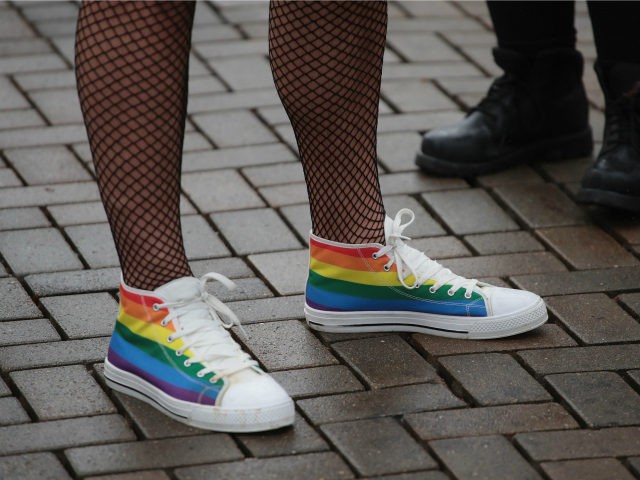Can any of you actually believe that things have
Post# of 65629

that things have come to this.
Cross dressers. Acting out.
In High school.
Where you are suppose to still be clean.

Students in Montgomery County schools in Maryland will be subject to sweeping new policies that cater to transgenders on campus, including promoting a gender-neutral dress code; options for gender, name, and pronouns; and “safe spaces.”
The six-page document issued by Montgomery County Public Schools includes everything from a list of gender “definitions” to instructions for developing plans for transgender students that could include a student’s parents “if the family is supportive of the student.”
The goal of the “guidelines” is laid out in a bulleted list:
Support students so they may participate in school life consistent with their asserted gender identity;
Respect the right of students to keep their gender identity or transgender status private and confidential;
Reduce stigmatization and marginalization of transgender and gender nonconforming students;
Foster social integration and cultural inclusiveness of transgender and gender nonconforming students; and
Provide support for MCPS staff members to enable them to appropriately and consistently address matters of student gender identity and expression
“Montgomery County Public Schools (MCPS) is committed to a safe, welcoming school environment where students are engaged in learning and are active participants in the school community because they feel accepted and valued,” the guidelines state. “To this end, all students should feel comfortable expressing their gender identity, including students who identify as transgender or gender nonconforming.”
The guidelines include a long list of “gender identity” definitions, including “agender” — “Without a gender (also ‘nongendered’ or ‘genderless’),” and “transgender” — “an adjective describing a person whose gender identity or expression is different from that traditionally associated with the person’s sex assigned at birth. Other terms that can have similar meanings are ‘transsexual’ and ‘trans.’”
The definition list also includes “transition”:
The process by which a person decides to live as the gender with which the person identifies, rather than the gender assigned at birth. In order to openly express their gender identity to other people, transgender people may take a variety of steps (e.g., using a nickname or legally changing their names and/ or their sex designation on legal documents; choosing clothes and hairstyles that reflect their gender identity; and generally living, and presenting themselves to others, consistently with their gender identity). Some, but not all, transgender people take hormones or undergo surgical procedures to change their bodies to align with their gender identity.
Dress codes, sports, and “safe spaces” are also addressed in the guidelines:
DRESS CODE
Transgender and gender nonconforming students have the right to dress in a manner consistent with their gender identity or gender expression, so long as it complies with the MCPS dress code. School staff members shall not enforce a school’s dress code more strictly for transgender or gender nonconforming students than for other students.
Schools should consider gender neutral dress codes for class or yearbook photos, honor society ceremonies, graduation ceremonies, or dances. In addition, in circumstances where gendered clothing is worn (e.g., in shows and performances), students should be allowed to wear the garments associated with their gender identity.
PHYSICAL EDUCATION CLASSES AND INTRAMURAL SPORTS
3⁄4 Whenever the school provides gender-segregated physical education classes and intermural sports, students must be allowed to participate in a manner consistent with their gender identity.
Safe Zones: Schools will designate certain teachers’ classrooms, specific offices, or a location in a school that is deemed a safe zone where any student, for whatever reason, may go to be free from judgment and to feel comfortable and safe. Schools also should ensure that staff members who have safe zone stickers on their doors have received appropriate training regarding providing inclusive, affirming environments.
Perhaps the most controversial aspect of the guidelines is instructing staff and students that parents may not always be involved in decisions made for transgender students, which is explained under the heading “Proactively working with transgender and gender nonconforming students”:
The principal (or designee), in collaboration with the student and the student’s family (if the family is supportive of the student), should develop a plan to ensure that the student has equal access and equal opportunity to participate in all programs and activities at school and is otherwise protected from gender-based discrimination at school.
Prior to contacting a student’s parent/guardian, the principal or identified staff member should speak with the student to ascertain the level of support the student either receives or anticipates receiving from home. In some cases, transgender and gender nonconforming students may not openly express their gender identity at home because of safety concerns or lack of acceptance. Matters of gender identity can be complex and may involve familial conflict; if this is the case, and support is required, the Office of School Support and Improvement or the Office of Student and Family Support and Engagement (OSFSE) should be contacted.
In such cases, staff will support the development of a student-led plan that works towards inclusion of the family, if possible, taking into consideration of safety concerns, as well as student privacy, and recognizing that providing support for a student, even when the family is non- supportive is critical.
The guidelines also link to an “intake form” for students, where they can choose their gender — male, female, or other — and their preferred pronoun and name if the latter differs from their official school registration where their birth name might have been used
 (0)
(0) (0)
(0)